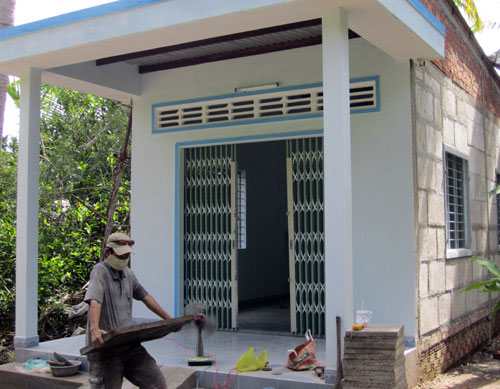Build houses from coconut shells
Using coconut shells to make light concrete for building materials is the solution of Nguyen Tan Khoa (studying MSc in construction major at Sejong University, Korea).
Recently, a 48m 2 house built from 4 tons of waste coconut shells was inaugurated in Mo Cay district, Ben Tre province.
From coconut shells to concrete
Tan Khoa said, when he was studying construction major at Ho Chi Minh City Polytechnic University, Khoa noticed that, in the coconut processing industry, the source of coconut shell waste is huge. But the use of coconut shells (activated carbon, handicrafts) accounts for a very small proportion because of complex processing technology and high cost. Therefore, a large amount of waste into the environment has caused waste and pollution. Meanwhile, many studies show that coconut shells have characteristics (hard, flexible) suitable for making concrete.

The house of 48m2 is built from lightweight concrete slabs made from coconut shells.
If using coconut shells to make concrete, it will solve the waste from coconut processing technology that has just created materials for construction. From this thought in addition to the knowledge of construction materials at school, Khoa immediately began to study.
Khoa said this job is also quite difficult: Read the documents, calculate the numbers and the tests. Finally, the process of producing coconut shell concrete is also completed. Khoa explained, after choosing coconut shells (coconut shells, the thickness of the ladle reaches from 2.5 to 3mm), the shell will be removed and removed. The next step is to process coconut shells with a hammer beating machine. Coconut shells will be crushed with a size of 10mm. Particles larger than 10mm will be put back into the machine.

Author Nguyen Tan Khoa (left)
After crushing small coconut shells are treated with alkaline solution at high temperature to ensure durability for concrete. The most important step in all this stage is to build concrete. The components used to make concrete include cement as a binder, sand (small scale), treated coconut shells (large ingredients), water and additives. These ingredients will be mixed in a certain proportion.
The results show that, from coconut shells, it is possible to create concrete wall panels with a volume of 1,400 - 1,700kg / m3, the compressive strength of concrete is from 50 - 100kg / cm 2 (standard to do wall is 30kg / cm 2 ).
Come to the house against the flood
Tan Khoa revealed that after the research, Khoa had this idea to take the Green Idea Contest organized by the Ministry of Education and Training, the General Department of Environment (MoNRE) Toyota Vietnam Motor Company. Having won the second prize, Khoa received a sum of VND 250,000 million from the organizing committee to realize the idea.

This house has proven that light concrete from
Coconut shells can be used to build houses.
Dr. Pham Anh Tuan, lecturer of Ho Chi Minh City University of Technology, who helped Khoa carry out the project when Khoa went to study abroad, said that on September 14, with nearly 4 tons of waste coconut shells, a 48m 2 house built in Mo Cay district, Ben Tre.
Unlike traditional house construction, this lightweight concrete construction is done by constructing a steel frame, then using nails to link lightweight concrete blocks to the steel frame. Specifically, this 48m 2 house uses up to 600 light coconut shell panels (these lightweight concrete slabs have 2 sizes of 40 x 60cm and 50 x 100cm).

Due to the use of lightweight concrete slabs on the iron frame, therefore,
This house can be easily assembled and dismantled quickly.
From overseas, Tan Khoa said that this house has proved that lightweight concrete from coconut shells can be used to build houses. Building this coconut shell house will be like a multi-target arrow. The first is to take advantage of local waste materials to grow coconuts. The second is to reduce the cost of building houses (this construction cost of light concrete houses is reduced by 20% compared to building houses with traditional methods).
Due to the use of lightweight concrete panels paired on iron frames, so this house can be fully assembled and dismantled quickly. Houses of this type are suitable for use in flooded areas. In addition, it is also possible to build houses of this type to serve as accommodation for workers, to build houses at construction sites .
- Houses made from coconut will help people reduce concerns about natural disasters
- Benefits of coconut oil for human health
- The detailed process of building mini houses according to the standard of building real houses
- Fabrication of automobile parts from coconut
- Reduce thirst for electricity with coconut
- 11 reasons to drink coconut water
- Circus octopus
- He contemplated the garden of
- NASA invests in technology to build houses on the moon
- Build houses with mammoth bones
- Facebook builds houses just to teach AI lessons
- Singapore will create houses for people with 3D printing and assembly technology like Lego
 'Barefoot engineer' invents a pipeless pump
'Barefoot engineer' invents a pipeless pump Process of handling dead pigs due to disease
Process of handling dead pigs due to disease Radiometer
Radiometer Warp Engine: Technology brings us closer to the speed of light
Warp Engine: Technology brings us closer to the speed of light Unique communication of coconut crab
Unique communication of coconut crab  10 unexpected harm from coconut oil
10 unexpected harm from coconut oil  See octopus cleverly dressed as a clam to trick crabs
See octopus cleverly dressed as a clam to trick crabs  See the biggest crab on the land clear the body of a ... pig
See the biggest crab on the land clear the body of a ... pig  Useful tips for everyday life
Useful tips for everyday life  A lot of people made a mistake in the addition
A lot of people made a mistake in the addition 